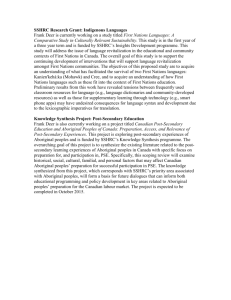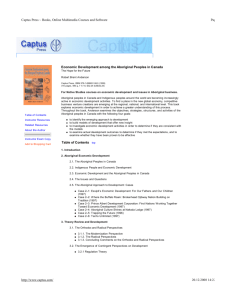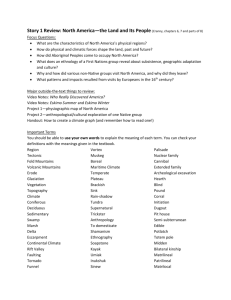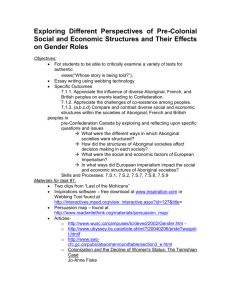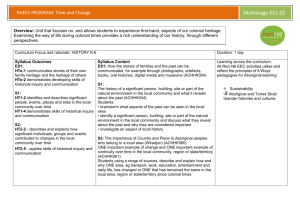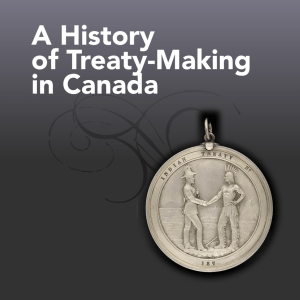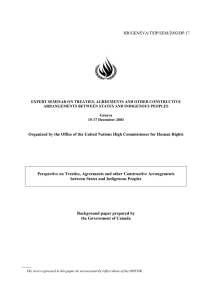Native self-government
advertisement
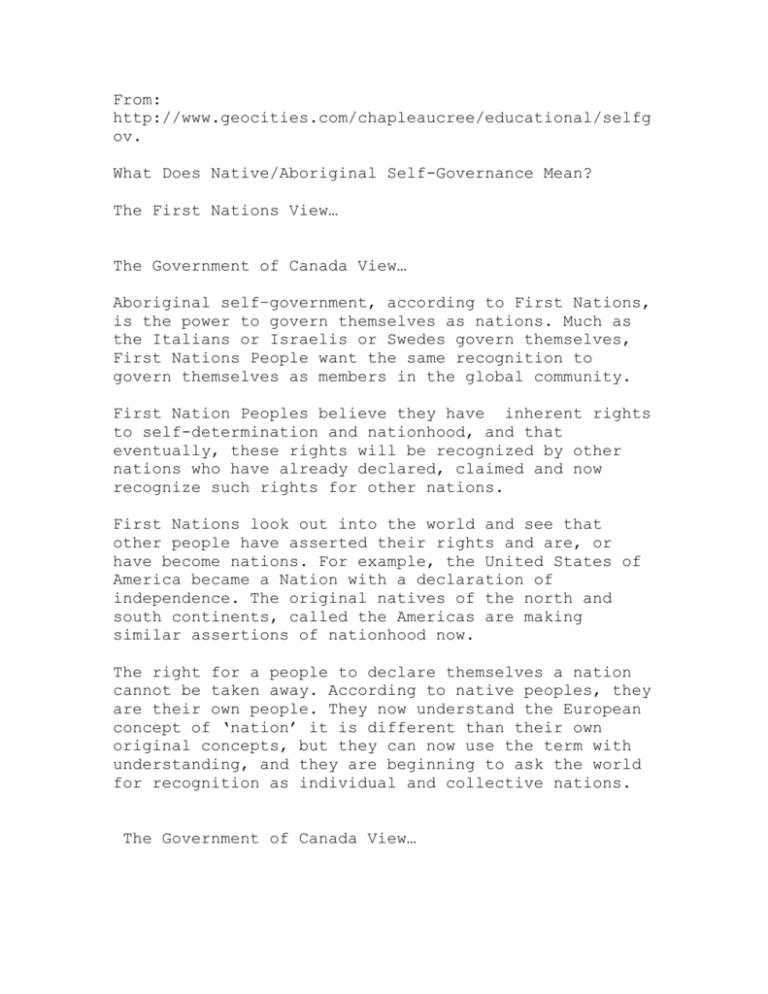
From: http://www.geocities.com/chapleaucree/educational/selfg ov. What Does Native/Aboriginal Self-Governance Mean? The First Nations View… The Government of Canada View… Aboriginal self–government, according to First Nations, is the power to govern themselves as nations. Much as the Italians or Israelis or Swedes govern themselves, First Nations People want the same recognition to govern themselves as members in the global community. First Nation Peoples believe they have inherent rights to self-determination and nationhood, and that eventually, these rights will be recognized by other nations who have already declared, claimed and now recognize such rights for other nations. First Nations look out into the world and see that other people have asserted their rights and are, or have become nations. For example, the United States of America became a Nation with a declaration of independence. The original natives of the north and south continents, called the Americas are making similar assertions of nationhood now. The right for a people to declare themselves a nation cannot be taken away. According to native peoples, they are their own people. They now understand the European concept of ‘nation’ it is different than their own original concepts, but they can now use the term with understanding, and they are beginning to ask the world for recognition as individual and collective nations. The Government of Canada View… Aboriginal self–government, according to Canada, is the power, granted to aboriginal people within boundaries of Canada, to govern certain activities concerning themselves, within the existing structures of Canadian government, and with accordance to the Canadian Charter of Rights and Freedoms. (Some of the more recent steps towards limited self government are listed in the attached ‘History/Timeline’ section later in this article.) The existing structures mentioned above are the Federal and Provincial government systems. Within the space left over, First Nations must carve out and define policy and methods of government (or management), much the same as municipalities and corporations do in their respective charters of incorporation. With some minor exceptions, then, self-government, according to Canada, is a ‘downloading’ of administrative functions to the First Nation. The movement to self-governance, combined with Native issues settlements is what has been identified, in Canada’s strategies, as the ‘devolution process;’ a process to integrate First Nation peoples into mainstream Canada. In effect, the process intends to resolve outstanding issues by, once and for all, settling aboriginal issues such as outstanding land claims and violated rights with final land settlements and money. The Current Problem Clearly then, if these are the initial positions of two different views, there is a problem. Presently, there is serious debate as to the exact nature of this problem. It revolves around what the future will be. Do First Nations really want to be independent of Canada? Do First Nations really have the right to consider that self government can actually happen? Does Canada have the right to confine First Nations and their people? Are the initial treaties legitimate, or are they faulty? Were these treaties bargained in less than a fair process? Did European nations have the right to ‘claim’ North American territories as they have? How far back can people go in order to clear up the situation? Should bygones be bygones? These are the questions that entwine themselves in the discussions and intentions towards Native/Aboriginal self-government. These are both emotional and political issues, and various discussions and steps are underway to bring these things to some form of resolution. The Aboriginal Rational for Self Government The right for a people to declare themselves a nation cannot be taken away. For example, Egypt and Syria were original Members of the United Nations from October 24 1945. Following a plebiscite on February 21 1958, the United Arab Republic was established by a union of Egypt and Syria and continued as a single member. Other nations of the planet recognized this union. On October 13 1961, Syria, having resumed its status as an independent State, resumed its separate membership in the United Nations. Again other nations recognized and respected this action. The Union itself recognized the legitimacy of separation. On September 2 1971, the United Arab Republic changed its name to the Arab Republic of Egypt to reflect the separation of the two peoples. The world community accepted and honored these changes. South and North American aboriginal peoples recognized and belonged to cultural and territorial organizations (somewhat or roughly equating to the European concept of ‘nation’) long before there were the political boundaries that now define Canada, the U.S.A., Mexico, the further south, of Peru, Venezuela, and Chile, etc. Inappropriately, these earlier Western Hemisphere organizations and their rights as nations were not recognized by those landing on the continents and islands we now call the Americas. Lands were claimed, colonies established, and an economy unlike any other before, introduced onto the land and into its peoples. In North America, the nations of France, Great Britain, and eventually Canada, in respective actions to create treaties with aboriginal people, had to first establish the European concept of, and existence of, ‘nations’ for the native peoples. It was necessary to create the treaty, in terms and concepts recognized by their own nationally accepted (European) systems of government, and modes of national interaction. To be ‘legal’ a treaty had, and still must, conform to an understanding of the concept of ‘nation’ and ‘delegates’ of nations. These were foreign ideas and concepts to native peoples. Over a period of years the treaties were signed. The Aboriginal peoples consider that not all of these treaties were brought into existence by legitimate means, and with informed choice of all parties. Basically, if one considers the current treaties between Aboriginal Peoples and Canada; those signing the treaty as agents for Canada were delegated according to a formal system of government that its citizens had knowledge of, accepted, and supported as a means to national unity. They were Canada’s representatives. They signed the treaties, according to the prescriptive systems in place, for Canada On the treaty documents also, are the signatures and marks of individuals who knew little or nothing about this elaborate system of concepts and policy, did not necessarily accept and support such a system, and were not systematically delegated to represent their respective peoples. The concept of national representation was truly a foreign idea. So too, were the words of the treaties, the concepts of property and ownership. This is not to say that these people were unintelligent, but that they did not fully and truly understand what was actually happening at that moment, and what would happen after they placed their names or marks on those few pages of paper. They ask, "Would any knowing person, in good conscience, agree to such terms?" Many people find that it would have been unreasonable for such an act to occur if those signing were truly aware of both the concepts that were identified, the concepts of a systematic government and of national representation. Those tiny marks on those few pages of paper have created an immense number of problems. Over the years, several approaches have lead to disagreements and to different resolutions. Attempt to resolve the issues still continue, especially, in Canada. A current strategy of First Nations is to develop constitutions that declare their rights and sovereignty. According to Canada, First Nation constitutions must logically fit within the context of the larger preexisting systems of Canadian government. First Nation self-government powers extend slightly beyond municipalities and corporations in a few areas. Canada has recognized that there are differences between first nations and other cultures, and has allowed First Nations some latitude not normally granted other cultural groups that live as Canadian citizens. It is a concession granted to reconcile the transgressions of the past. According to native peoples, we are our own people. We now understand the European concept of ‘nation.’ It is not one of our own concepts, but we can now use this term with understanding, and we are beginning to ask the world for recognition as nations. For more information check out this link http://www.mta.ca/about_canada/native/

